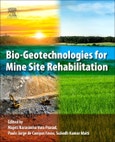Bio-Geotechnologies for Mine Site Rehabilitation deals with the biological, physical, chemical, and engineering approaches necessary for the reclamation of mine waste. As mining has negative effects on natural resources and deteriorates the quality of the surrounding environment, this book provides coverage across different types of mining industries, which are currently creating industrial deserts overloaded with technogenic waste. The book offers cost-effective strategies and approaches for contaminated sites, along with remediation and rehabilitation methods for contaminated soils and waste dumps. It is an essential resource for students and academics, but is also ideal for applied professionals in environmental geology, mineral geologists, biotechnologists and policymakers.
Please Note: This is an On Demand product, delivery may take up to 11 working days after payment has been received.
Table of Contents
Section 1 1. Abandoned Mine Reclamation holistic approach 2. Soil Quality Indices for Evaluation of Abandoned Mine Land [AML] 3. Indicators for Monitoring Mine Site Rehabilitation 4. Biotechnological tools for remediation of Acid Mine Drainage 5. Biotechnological tools for Mine Site Rehabilitation 6. Novel methods for the remediation of Acid Mine Drainage 7. Mine site restoration using sylvicultural approach 8. Engineered soils using amendments for in situ rehabilitation of AML 9. Aided Phytostabilization of Mine Waste 10. Fly ash and lime-stabilized biosolid mixtures for mine spoil reclamation 11. Iron oxide nanoparticles and reclamation of mine sites 12. Nanoenhanced Reclamation of Mine Spoils 13. Insights and lessons learned from the long-term rehabilitation of AMLs 14. Mycoremediation for mine site rehabilitation 15. Mycorrhizal fungi from mine sites and rehabilitation of AMLs 16. Plant growth-promoting rhizobacteria-assisted phytoremediation of mine soils
Case Studies 17. Brazil -Mine Site rehabilitation in Brazil 18. China Mine land reclamation of coal mine, A case study from China 19. Czech Mine Rehabilitation Technologies in Czech Republic 20. India Nyveli Lignite Mine Rehabilitation 21. Carbon sequestration and soil CO2 flux in reclaimed coal mine from India 22. Stabilization of iron ore mine spoil dump sites with vetiver system 23. India Techniques for evaluation of mine site reclamation success 24. Ireland Mine Sites Rehabilitation in Ireland 25. Japan Phytorecovery of mine-impacted agricultural land in Japan 26. Artisanal and small-scale gold mining waste rehabilitation with energy crops and native flora a case study from Nigeria 27. Poland Reclamation of post-mining sites in Poland 28. Poland Lignite Mine Waste reclamation 29. Russia Biological recultivation of Ural coal mines disturbed lands 30. Russia Mine land rehabilitation in the Russian Sub-Arctic 31. USA Mine waste remediation in United States 32. UK: Building a Cradle for Nature: A Paradigm for Environmental Reconstruction on degraded former surface coal-mine sites in South Wales, UK 33. Thailand Thai mining and bio-geotechnologies for sustainable development








